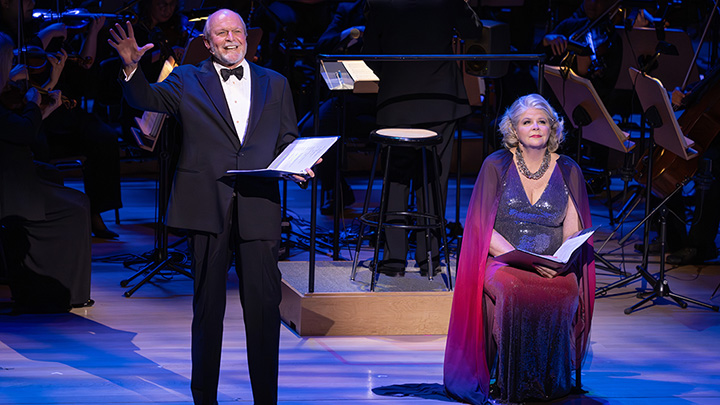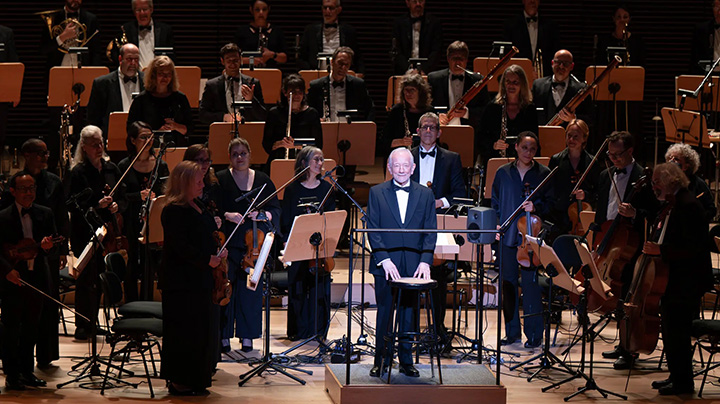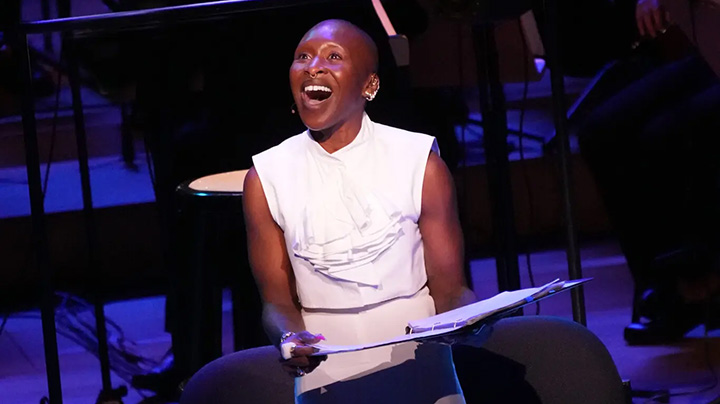Since he died in late 2021, Sondheim has seemingly become far more popular than he was when he was alive, with acclaimed recent revivals on Broadway of Into the Woods and Merrily We Roll Along, along with the posthumous premiere of Here We Are which was greeted with decidedly mixed responses. The two most recent instances of local Sondheim-fever occurred in late June with starry(ish) concerts of Follies at Carnegie Hall and A Little Night Music at Lincoln Center’s Geffen Hall.
Cameron Mackintosh’s production company decreed that no press tickets would be made available for Follies; however, after many emails, I nabbed a single press ticket for the final performance of Night Music, a project which was strenuously promoted as the world premiere of a new, expanded orchestration by lauded Sondheim veteran Jonathan Tunick who also led the 53-member of the Orchestra of St. Luke’s.
While the orchestrations revealed some slight, not always apt tweaking of his marvelous originals, Tunick’s leaden, unvaried conducting cast a damper over an earnest enterprise also marred by puzzling casting choices. Online comments as well as pointed put-downs relayed to me from friends who attended earlier performances lowered my expectations, but I enjoyed hearing Sondheim’s entrancing score live for the first time in over twenty years.
Though I’d rank it fifth among his 70s shows, Night Music was the first Sondheim original-cast recording I bought as well as the first of his shows that I attended. When I was in grade school, my grandmother took me to a few Kenley Players musicals each summer. Memorable Saturday matinees included Ethel Merman (and Russell Nype) in Call Me Madam; Ann Blyth and Andy Devine in Showboat; On a Clear Day You Can See Forever starring Shirley Jones; Vikki Carr as The Unsinkable Molly Brown; and Buddy Greco, Anne Jeffreys—and Dagmar–in Pal Joey. But as my interest in opera grew, I became less interested in the Kenley shows and eventually we stopped attending.
After a few years, however, I noticed that Kenley was presenting Night Music just two years after it closed on Broadway. It was real shock that Kenley produced two Sondheim shows that summer, but I wasn’t tempted by A Funny Thing Happened on the Way to the Forum starring Sonny Bono! I do regret missing Joanne Worley in Gypsy years earlier.
But as my mother had a buy-one-get-one-free coupon (as was her wont), I returned to Memorial Hall for Eva Gabor’s Desirée. My memory is that she was delightful: elegant and moving. A recent internet search reminded me that her colleagues were Earl Wrightson and Lois Hunt as Fredrik and Charlotte (I’d seen them previously in Blossom Time with Sally Anne Howes)–and Ethel Barrymore Colt was Mme Armfeldt—just months before she died at 65! New York City Opera’s production in 2003 with Juliet Stevenson, Jeremy Irons and Claire Bloom was my only other live Night Music which seemed very long thanks to Hugh Wheeler’s very talky book.
But Tunick’s version at Geffen used a succinct text abridgement by John Doyle who was originally to have directed. His place was taken by Marc Bruni whose modest Encores-based staging (with everyone carrying binders) got the job done. The musical, based on Ingmar Bergman’s film Smiles of a Summer Night, traces the life-changing romantic entanglements of several upper-class Swedes and their servants. Sondheim imbued his score with entrancing waltzes often sung by five “Liebeslieders” whose frequent commentaries stuck me this time as increasingly intrusive, perhaps because the performers were rather ordinary.
The show’s central love (or sex) triangle of Desirée, Fredrik and Carl-Magnus was crippled by performers—Susan Graham, Ron Raines, and Shuler Hensley–several decades too old. The frustration expressed by a husband in his 70s about not having yet taken the virginity of his very young wife had me squirming. Desirée’s teenaged daughter would suggest she’s in her 40s and enjoying the attentions of a robust Count in his 30s.
Not only were the three dramatically miscast, none were an ideal vocal match either, though Raines once he warmed up in the second act showed he would have been an ideal Fredrik back in the day. Graham, the cast’s sole opera star, was uneven in the role written for a non-singer. “The Glamorous Life” proved way too low for her, but she deftly performed a rueful “Send in the Clowns,” her best moment. She handled her dialogue well enough but failed to fully inhabit the insouciant yet fragile diva-flair of Desirée. Hensley found the Count’s music too high and frequently resorted to a gingerly attacked head voice for climaxes intended to ring out bravely.
On the other hand, Anne and Charlotte, the two mistreated wives, found splendid interpreters in Kerstin Anderson and Ruthie Ann Miles. Anderson’s crystalline soprano soared exquisitely, while Miles made her devastating “Every day a Little Death” sear with desperate frustration. Miles also got nearly all the evening’s laughs with her sharp delivery of the Countess’s many drop-dead quips. Like his father, Jason Gotay’s whiny Henrik read as too old, and he lunged painfully at his high notes.
Marsha Mason, cruelly miscast as the matriarch, was the evening’s complete disaster missing her character’s witty imperiousness. “Liaisons,” which can feel endless even with the best Mme Armfeldt, dragged on and on thanks to Tunick’s funereal tempo. Mason, more than anyone, seemed unsure of her lines and fervently clutched her script. Jin Haselflessly wheeled her about as Frid until he got his big restored number, “Silly People.” He handled it well, but its harshly bitter tone arising from out of nowhere suggested its early omission from the score was correct.
Frequent advertisements for Night Music on Facebook might have led unsuspecting ticket-buyers to believe that Cynthia Erivo was the show’s star when Petra is actually quite a small role. She does, however, get “The Miller’s Son,” a striking, show-stopping number about romantic aspirations. Ervio’s dialogue was often difficult to understand (the amplification throughout was otherwise well-handled), but she spit out the stinging words of her song with thrilling élan. I’m told she lost her place at the Saturday matinee and had to begin the song again; no such accident happened when I saw her though she, like Mason, relied heavily on her script.
Night Music’s “happy” ending felt less moving this time with both recently abandoned men–Fredrick and Carl-Magnus—settling for the woman waiting selflessly by for them. I understand that Tunick’s new orchestrations will be recorded, but I pray it won’t be with this far-from-ideal cast under his uninspired direction, though the Orchestra of St. Luke’s played gorgeously.
Though I missed the Follies performed a week earlier, I have a pirate recording of the special event which, unlike the four wildly overpriced ALNM shows that initially sold poorly, was an instant sell-out. It was a novel dialogue-free presentation in which two narrators introduced each number. The adrenaline-pumped audience screamed vigorously for every Broadway veteran who performed just one song which meant there were at least five Sallys.
There were many highlights (along with just a couple lowlights), and I’ll leave you with recordings of two selections about which there may be differing opinions. Christine Ebersole’s glorious “In Buddy’s Eyes” made me tear up when I heard it, while Jennifer Holliday’s epic “I’m Still Here” reminded me that, like “The Ladies who Lunch,” I’ve heard her anthem far too many times.
Stephen Sondheim: Follies (excerpts) (New York 2024)
“In Buddy’s Eyes” (New York 2024)
Christine Ebersole
“I’m Still Here” (New York 2024)
Jennifer Holliday
Carnegie Hall, June 20, 2024
Photo credit: Joan Marcus







